Jade River: A History of the Mahurangi
Ronald H LockerFirst published 2001. Published online 2014–. This online edition is a work in progress…
Pages 234–238in printed edition
Once veritable Rodmersham art gallery
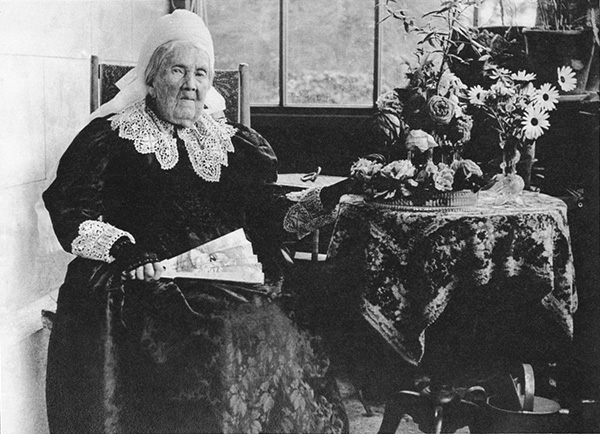
The widowed Susannah Styak (mother of Sarah Jane Lushington) who arrived in New Zealand from New South Wales in 1847 and whose husband John, a foreman-architect with the Royal Engineers, had oversight of the Fencible Settlement at Howick, Auckland. image Family archive
Had the settlement of Nelson been sited at Mahurangi as Hobson had urged, the class structure of England would have been transplanted to the Mahurangi.
But the New Zealand Company would have none of it. Instead, Mahurangi became an egalitarian place, home to settlers whose means varied from minute to modest. Very few wrote themselves on the electoral rolls as ‘gentlemen’. It followed that there was a dearth of gentlemen’s residences. On the harbour itself there has been only one—Rodmersham, once better known to the locals as Lushington’s or Wynyard’s. In the snug bay inside the eastern head, the two-storied house still stands, half hidden by a great Norfolk Island pine. What would pass as a modest manor-house in England has, in this setting, an air of substance. There is a mysterious sense of seclusion about it. Many who pass on the water must have wondered at its story which, being out of the ordinary, I have chosen to tell.
The land was bought in the earliest land sales (1853) by John Sullivan. He first built a cottage at Dairy Bay (still standing and in use), and lived there with his wife and two children. When Sullivan died in 1883 the land was left to his seafaring son William and to his son-in-law, William Benjamin Jackson. They sold it within three months (4 January 1884) to an Englishman named Robert Arthur Ponsonby Brooke, an enigmatic figure from Bradford. He had decided to emigrate. So the building of the big house was set in train in 1884. It is said he planned ultimately to build a grander one in Lagoon Bay. While the building was in progress, Brooke returned to England to settle his affairs and collect materials for his house, but died there on 11 February 1885. At this time, only the shell of the house was complete.
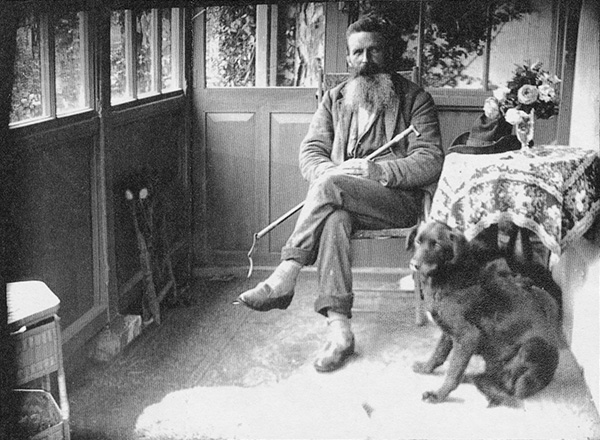
The farmhand and his faithfull dog. Alex Trotter photographed at Rodmersham. image Family archive
The unfinished house, together with over acres 300 acres of farmland was bought in July 1886 by Sarah Jane Lushington. She was the daughter of John and Susannah Styak (nee Cooper), who had come to New Zealand in 1847 from New South Wales. John Styak was foreman-architect with the Royal Engineers and responsible for the building and oversight of the Fencible cottages at Howick. Eventually he took up an extensive acreage at East Tamaki, built his own home there and called the property Greenmount (now the site of an Auckland industrial estate). John Styak died in 1877. One person who lent a helping hand to the Styaks after John Styak’s death was a young Englishman by the name of Charles Hugh Lushington who had arrived in Auckland in 1881. Charles was the only son of Charles Hugh and Caroline Lushington of Rodmersham Lodge, Sittingbourne, Kent. The younger Charles was born in 1862 and educated at Cheam and Eton and had the distinction of being a natural athlete. Tall and muscular, he excelled at swimming, rowing and fives, as the collection of trophies at Rodmersham testifies.
In 1884, Sarah and Charles were married. Initially, they lived at Greenmount. During this time two events took place which caused them to move to Mahurangi. In England, Rodmersham Lodge was sold and Charles’ father moved to London, and in Aotearoa, the stables at Greenmount had been destroyed by fire and the nearby wooden homestead badly scorched. The first event precipitated much of the Lushington estate being shipped out to Aotearoa and this included a very fine collection of Old Master paintings. Plainly, to hang these paintings in a wooden house was courting disaster, so the Lushingtons looked around for a less flammable home for themselves, and for what they knew to be a very valuable collection. They found it in the lime cement house on the eastern shore of the Mahurangi, a house which to Charles’ mind bore an almost adventitious resemblance in architectural form to his family home in Kent.
Brooke’s original intention of finishing the house with imported materials was discarded by the Lushingtons in favour of the more expeditious use of local materials and fittings. Thus a house begun in Georgian style was finished in contemporary Victorian fashion. Nevertheless, a grand house by New Zealand colonial standards was the result. Walls a foot thick and without structural reinforcement have stood soundly for more than a century. Beach sand and shell, shingle from Motuora and lime from the local kilns up-river went into it. The exterior plaster had lines drawn on it to simulate masonry. The roof was of slate, a common ballast cargo of those times. It was replaced by corrugated iron during World War 1. Even though some concessions have been made to modern living, the structure has been carefully maintained, and so the house retains an authentic Victorian character.
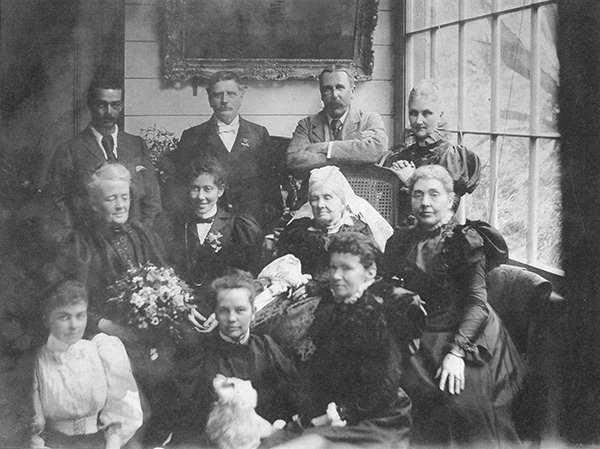
Friends and family meet at Rodmersham, late 1800s. Those identified are, back row, second from right, Charles Hugh Lushington, third from left, her mother Susannah Styak. Front row, from left, Ella Wynyard (née Eaton) and her mother Theresa Eaton (née Styak) with the family dog. image Family archive
Sarah Lushington brought with her to Mahurangi, her widowed mother, Susannah Styak, her widowed sister, Theresa Eaton together with her niece, Ella Eaton, Ella was treated as a daughter, as the Lushingtons had no children of their own. From time to time, the household expanded to include visiting relatives, picnic and shooting parties and passing yachtsmen. The noted photographer Henry Winkelmann was a regular visitor. Such occasions demanded extra staff and this was a welcome local source of employment. Some of my own aunts and uncles got their first jobs there. There was the farmhand, Alex Trotter who lived in Dairy Bay Cottage; the gardener, John Paseden Kara who, when he had saved enough money returned to his family in India; the housemaid, Miss Pritchard; the dairy man, Charles Emtage who lived at Motuora Island and kept the grates and stoves in firewood; and the most treasured and long-serving cook, Margaret Robb whom Mrs Lushington looked after in her dotage. And there was Mrs Brown, the cleaning woman or skivvy who lived at first in an upturned boat, later in a small cottage at Quinns (Poplar) Bay, Te Kapa, and who walked at least a mile along the shoreline, three times a week to attend her duties at the house. Her husband was a drinker and gave her a hard time. She was poorly educated and Mrs Lushington helped her with her finances and looked after her welfare.
On one of his visits to Rodmersham, Winkelmann took a series of photographs which provide some enchanting images of life on the River. One is a study of Mrs Styak seated in the conservatory and strongly resembling Queen Victoria, another is of Mrs Brown on the doorstep of her cottage and yet another shows Mrs Lushington and Mrs Brown enjoying the beach, the former sitting on a pile of ballast pig iron from the Muritai canted on the shore behind. The yacht had been damaged in hauling out and was later sold. The Muritai was one of several craft the Lushingtons owned. Another was the yacht Belle and later the launch Mahunga. When Ella Eaton married Robert Henry (Harry) Wynyard at Rodmersham in 1898, the yachts were all decked out in bunting. The newspapers of the day reported the guests sat down to an excellent wedding breakfast and the health of the bride and groom was drunk three times three!
The Lushingtons were close friends of Major John Whitney and his family. Whitney was the founder/owner of the Colonial Ammunition Company and had acquired Wenderholm near Waiwera in 1896. The two families socialised together regularly with picnics and boating parties and both their houses and families entertained friends, business colleagues and other notables from Auckland.
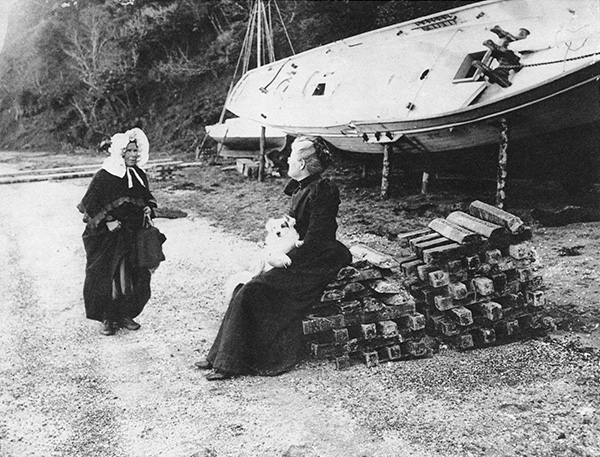
This Henry Wilkelmann photograph records a unique aspect of life on the Mahurangi Harbour in the 1800s. The mistress of Rodmersham, Sarah Jane Lushington, seated on a pile of ballast, greets her cleaning lady, Mrs Brown, who has walked along the shoreline to attend to her duties in the house. The ballast is from the Lushington yacht, Muritai, canted on the shore behind. image Family archive
Charles Lushington had the ill-luck to be a passenger on the Kapanui when she was hit by the Claymore and sank in the dark off North Head, Auckland, on 23 December 1905. The Kapanui was travelling to Auckland and was not showing a port light. Being a strong swimmer, he spent a long time in the water rescuing others. He caught pneumonia and died at the relatively young age of 43.
His widow continued to live at Rodmersham until the late 1920s when, aged 82, she decided to move to Remuera. This entailed moving the art collection back to the insecurity of a wooden house. The collection had been valued in 1911 by the prominent Auckland artist L J Steele. It was an impressive collection of Old Masters: Italian, Dutch, French and English. A totally unique decoration to the walls of a New Zealand home, let alone to an isolated one on the shores of the Mahurangi. The paintings that Steele put the most value on were: Judith and Holofernes, Guido Reni; Samuel Anointing David, Tiepolo; Rabbi’s Head, Rembrandt; Siege of Belle Isle by Admiral Keppel, Serres Dominique; Landscape, Ruysdael; River Scene, Ruysdael; Conversation Piece, Watteau; Landscape, Decker; Holy Family, Domenichino.
Mrs Lushington’s move to Auckland and to a wooden house, prompted her to realise on the collection. The paintings were sent in batches to Christie’s auction house, London. So was dispersed probably New Zealand’s first and last great art collection. Most of the original furniture was moved back to Auckland at this time and the majority has been distributed amongst the family. Much of the silver has been given to the Auckland Museum. Many of the original plants are still in the garden however, including the Norfolk Island pine, the mulberry tree, a very tall pear tree (which gives an abundance of small green and very juicy pears at the end of January every year) and numerous palms.
Harry Wynyard was the grandson of Lt General Robert Henry Wynyard who arrived in New Zealand in 1845 with the 58th Regiment for Heke’s war and played a major role in ending it. Lt General Wynyard later became the Commander of Military Forces in New Zealand, was Lieutenant-Governor of New Ulster (1851–53) and Superintendent of the Auckland Province (1853–55). He was Acting Governor when Sir George Grey left New Zealand in 1854.
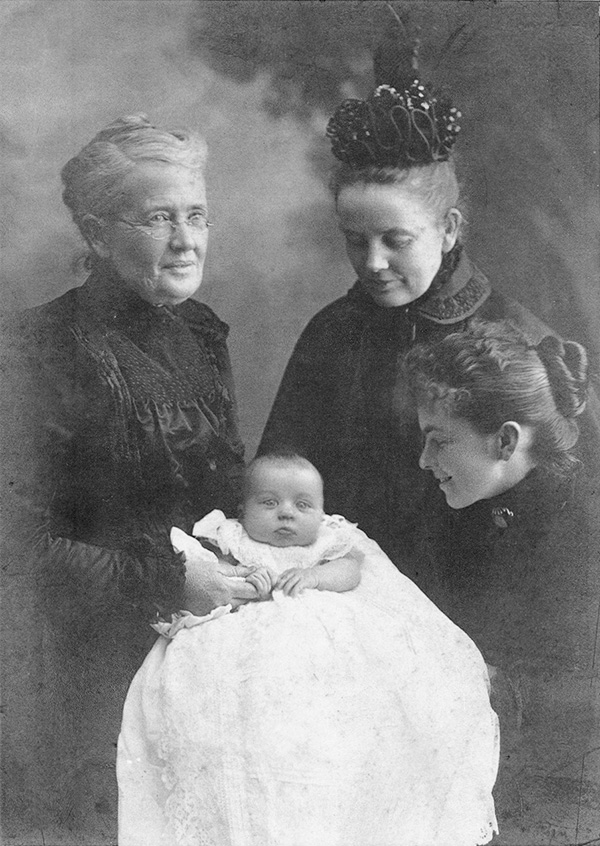
In 1900 at his christening Gladwyn Lushington Wynyard, later to farm the Rodmersham property, is admired by his mother Ella, right; her mother, Theresa Eaton, right rear; and his great-aunt Sarah Jane Lushington. Gladwyn died in 1973 and his estate passed to his daughter, Lindsay, who with her husband Mark Kirby, still farms the property. image Family archive
Harry and Ella Wynyard had five children: Gladwyn, Susan, Clinton, Edward (Ted) and Annette (Dolly). Rodmersham was like a second home to them. When she died in 1933, Mrs Lushington left the property to her eldest grand-nephew, Gladwyn Wynyard. Gladwyn retained the Mahurangi property and took a deep interest in the area. His unpublished Notes on Early Mahurangi is a useful historical document, which has supplied information for this and other chapters. Ted Wynyard worked on the neighbouring farm belonging to the Shores (formerly Darrach’s property) and later married Molly Shore. After the death of his father-in-law he and Molly moved to the cottage at Dairy Bay and farmed the Rodmersham property as a dairy farm for a short time. Eventually they moved to a farm in Woodcocks Road, Warkworth. When Gladwyn died in 1973 Rodmersham passed to his daughter, Lindsay, and her husband Mark Kirby, thus maintaining a continuous residence by family of well over 100 years.
Despite being better known by the surname of its first male occupant for more than a century, Rodmersham was mostly a matriarchy, as Lindsay describes:
Three very strong women are important in the history of Rodmersham: Sarah Jane Lushington, who outlived her husband by nearly 30 years and was always known in the family as Dah; her sister Theresa who was known as Granny Eaton and my own grandmother, Ella Maud Eaton. Granny Eaton was a lady of great energy and accomplishments. A keen gardener, she kept the house in vegetables and flowers. She fished from the shelf below the head and local people referred to it as Granny Eaton’s Point. She was fond of oysters and poached them as desired. She is known to have conversed with the oyster inspectors with jars of the bivalve secreted under her voluminous skirts. She was an accomplished artist and wood carver, her work is scattered among her descendants.
Although a portion was added to the Mahurangi Regional Park in 1972, the Kirbys continue to farm the remainder of the property and live at Rodmersham. There is a notable pa site with ditches intact and elaborate terracing on Sadler Point (the east head). Part of the pa is on the two-acre lighthouse reserve under the control of the Department of Conservation.
Update In 2015, Auckland Council acquired a further spectacular 20 hectares, Bush Point, situated at the northern limit of the Rodmersham property, to add to Mahurangi Regional Park.

Very good young man you can go on holiday now. No late nights at the Kaponga, and lots of Love to Christine. Haere Atu ki Taranaki…
Thank you for publishing such an interesting article about my relatives—the Lushington family. What you probably were unaware of is that Robert Arthur Ponsonby Brooke was a ‘cousin’ of Charles Hugh Lushington.
The connection is that they are both descendants of James Wilson, an Attorney who lived in Kendal, Westmorland, England.
James’ eldest daughter Catherine, married Christopher Wilson of Abbot Hall, Kendal (which is now a museum and art gallery). Their daughter married Miles Ponsonby of Haile Hall in the county of Cumberland and along with other children, had a daughter called Dorothy Jane who married in 1859, Robert Arthur Brooke.
Robert died within a year of the marriage, but they managed to produce a son and heir: Robert Arthur Ponsonby Brooke. Unfortunately, Robert junior died shortly after getting married in 1885 and so this line died out.
As regards Charles Hugh Lushington, he is a descendant of James Wilson through his younger daughter, Barbara Wilson who married the Rev. William John Lushington of Rodmersham, Kent. They produced a large family but only two of them had issue: Barbara, who married James Morant and Charles Hugh (the elder) who married in India in 1840, Caroline Eleanor Thompson. It was their only son who bought the property and married Sarah Jane Styak.
Can you confirm that there were no children to this marriage?—or did they die in infancy?